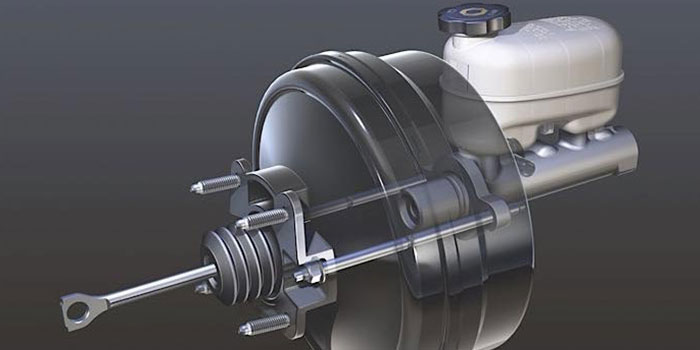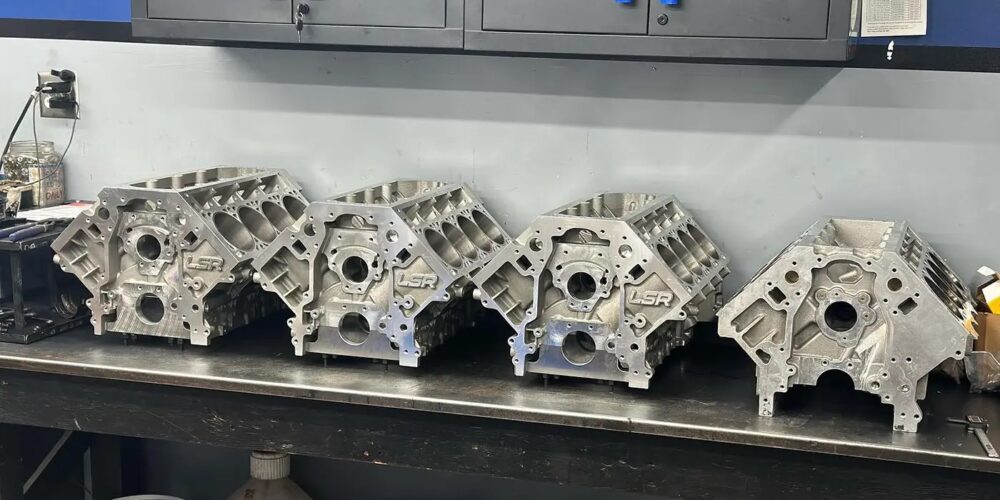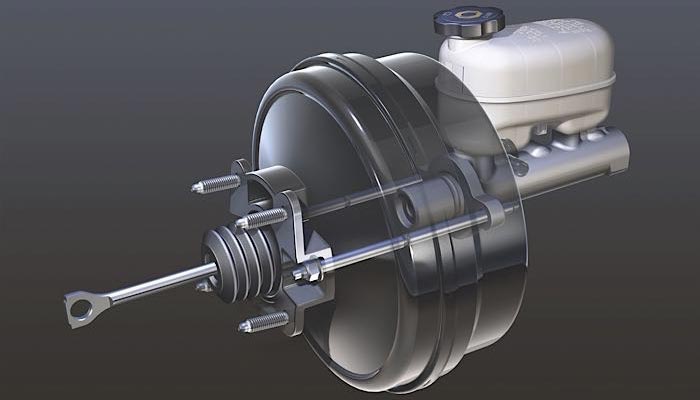
Vacuum boosters require three basic tests:
Booster Function Test: Check pedal feel and vacuum booster function while test-driving the vehicle. With the engine off, apply the brake pedal repeatedly with medium pressure until the booster reserve is depleted. At least two brake 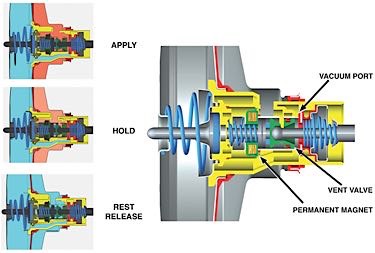 applications should have a power-assisted feel before the pedal hardens noticeably. If the pedal feels hard immediately, or after only one brake application, it may indicate a vacuum leak or a low level of engine vacuum. Inspect the vacuum hose to the booster for kinks, cracks or other damage. Check vacuum at idle with a vacuum gauge.
applications should have a power-assisted feel before the pedal hardens noticeably. If the pedal feels hard immediately, or after only one brake application, it may indicate a vacuum leak or a low level of engine vacuum. Inspect the vacuum hose to the booster for kinks, cracks or other damage. Check vacuum at idle with a vacuum gauge.
To test booster function once the reserve is depleted, hold moderate pressure on the brake pedal and start the engine. If the booster is working properly, the pedal will drop slightly.
Booster Vacuum Supply Test: With the ignition off, pump the brake pedal to deplete the booster reserve. Disconnect the vacuum supply hose from the booster and connect a vacuum gauge to the hose using a cone-shaped adapter. Start the engine and allow it to idle while observing the vacuum gauge. Although the amount of vacuum will vary by application, most will register between 15 inHg and 20 inHg (50 kPa and 70 kPa) at idle.
Disconnect the vacuum booster supply hose and check for source vacuum with a gauge.
If the reading is low, check to see if the vacuum hose is kinked, clogged or cracked. If the hose is not at fault, suspect an engine mechanical problem such as leaky valves, worn rings, an intake manifold vacuum leak, improper cam timing, etc.
Vacuum Inlet Check Valve Test: To test the vacuum check valve, disconnect the vacuum supply hose from the intake manifold or vacuum pump, and blow into the hose. If air passes through the valve into the booster, the check valve is defective and should be replaced.
Hydro-Boost Power Assist Service
The hydro-boost power assist system performs the same function as the vacuum assist system in helping apply a vehicle’s brakes. The difference is that the hydro-boost system uses hydraulic pressure instead of vacuum to provide power assist for the brake system. By using hydraulic pressure, a greater amount of assist can be provided.
The hydro-boost uses pressure from the power steering pump to provide braking boost, and includes a high-pressure accumulator that has enough capacity to provide several power-assisted stops in the event that the power steering pump belt breaks or a hose ruptures.
When inspecting the hydro-boost system, the inspection must include checking power steering hoses and pump for leaks, power steering fluid level, and drive belt tension. Hydro-boost operation and accumulator performance must also be tested.
Hydro-Boost Function Test: With the engine off, apply the brake pedal five or more times with medium force to discharge the accumulator. The pedal feel will harden noticeably. Next, apply the brake pedal with medium force and then start the engine. If the booster is working properly, the pedal will drop toward the floor and then push back upward slightly. If the booster passes this test, perform the accumulator test as described in the following section. However, if there is no change in the pedal position or feel, the booster is not working. Check the power steering system to determine whether the problem is in the pump or the booster.
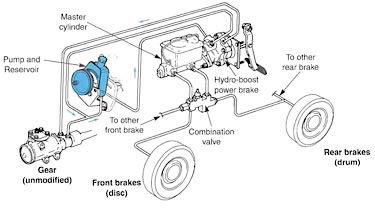 Hydro-Boost Accumulator
Hydro-Boost Accumulator
Similar to the vacuum booster, the hydro-boost is equipped with a backup or reserve in case the source of pressurized fluid is lost.
In the event of a loss of pressurized fluid, the accumulator will provide two to three power-assisted stops. Upon the first application of the brakes after an engine stall or loss of power steering, you would find approximately 60% to 75% of the normal assist available. If you were to release and apply the brakes again, you would find approximately 30% to 40% assist, then again approximately 10% to 20% until you depleted all stored reserve assist. Once you have depleted all of the stored pressure, the brakes will no longer have power assist and will be manual in their operation.
Hydro-Boost Accumulator Test: To test the ability of the system to store a short-term high-pressure charge in the accumulator, start the engine and allow it to idle. Charge the accumulator by turning the steering wheel slowly one time from lock to lock. Do not hold the steering at full lock for more than five seconds. Switch the engine off, release the steering wheel, and repeatedly apply the brake pedal with medium force. If the accumulator can hold a charge, a Hydro-Boost I unit will provide two or three power-assisted applications, while a Hydro-Boost II unit will only provide one or two.
To test the ability of the system to store a long-term charge, start the engine and recharge the accumulator as described previously. As the accumulator charges on a Hydro-Boost I system, a slight hissing sound should be heard as fluid rushes through the accumulator-charging orifice. Once the accumulator is charged, switch the engine off and do not apply the pedal for one hour. At the end of the hour, repeatedly apply the brake pedal with medium force.
If the hydro-boost unit fails these tests, it usually means the accumulator of a Hydro-Boost I unit, or the accumulator/power-piston assembly of a Hydro-Boost II unit, is leaking. In either case, the booster must be rebuilt or replaced. However, if a Hydro-Boost I system fails the test but does not make the hissing sound to indicate the accumulator is charging, the fluid in the system is probably contaminated. Simply flushing the hydro-boost system may cure the problem.
Never begin any work on a hydro-boost system until you have discharged the dangerously high pressure stored in the accumulator by pumping the brake pedal numerous times with the engine off.
Review Questions
1. Technician A says that with the engine off, you should feel that power assist is present for at least two pedal strokes with a vacuum booster. Technician B says the vacuum in the booster should disappear immediately when the engine is shut down. Who is right?
a. Technician A
b. Technician B
c. Both
d. Neither
2. If a vacuum power booster is in good condition, starting the engine after the booster has been depleted will cause the pedal to:
a. Sink slightly
b. Pulse rapidly
c. Rise slightly
d. Stay the same
3. When you blow into a vacuum check valve in the direction of the intake manifold:
a. Air should pass through freely
b. Air should not pass through
c. Air should pass through with difficulty
d. You should feel the check valve vibrate
4. With hydro-boost, when you discharge the accumulator then start the engine, the pedal should:
a. Push back
b. Push back, then sink toward the floor
c. Sink then push back
d. Sink toward the floor
5. Technician A says that the hydro-boost system performs the same function as a vacuum assist system. Technician B says that the hydro-boost accumulator can provide one or more brake pedal applications in the event of a power steering system hydraulic failure. Who is correct?
a. Technician A
b. Technician B
c. Both
d. Neither
The answers are posted in the Teacher Log-in section of www.TomorrowsTechnician.com.
Courtesy Brake & Front End.

